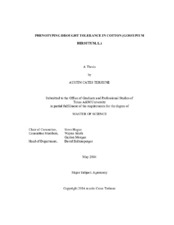| dc.description.abstract | Cotton plant breeders need well-defined phenotypic parameters by which they
can select drought tolerant lines as well as correlate phenotypes to allelic polymorphisms
in the cotton genome. Soil-moisture availability is usually the most limiting factor for
cotton crop productivity, especially in Texas. Characteristics of roots logically play an
important role in determining the response of plants to limited soil moisture.
The objectives of this study were to develop and refine techniques that could be
used by plant breeders to phenotype plants’ drought tolerance. Approaches include using
a Trimble GreenSeeker®, to identify individual and progeny rows with enhanced
photosynthetic capabilities in the presence of drought, leaf canopy temperatures under
drought conditions, and measurement of root parameters in growth tubes in a
greenhouse. Results from these experiments were related to yield performance in field
trials at three locations in 2013.
Several conclusions can be drawn from this study. First, Normalized Difference
Vegetative Index and leaf temperature are rapid and reliable tools to evaluate plant
health. The utility of these tools hinges upon timing of data collection, but they clearly
demonstrated the propensity to differentiate phenotypic differences. Secondly,
evaluation of root systems in growing tubes in a greenhouse is probably an ineffective
method of characterizing drought tolerance potential since the growing conditions are
radically different from what a plant would encounter in a field environment. Examining
roots with this system would likely yield significant differences among plant species, but
within upland cotton, it would be difficult to determine differences among genotypes.
Ultimately the best determinant of drought tolerance is performance testing in droughty
conditions because it encompasses most of the contributing factors that induce drought
stress and measures the cotton plant’s inherent ability to recover and compensate in
response to rainfall through the course of a growing season. | en |


